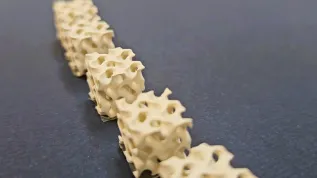
For robots to efficiently move not only in the laboratory, but also in an apartment or street, research using artificial intelligence is needed. It will be conducted by a new research team established at IDEAS NCBR.
IDEAS NCBR is a research and development centre operating in the field of artificial intelligence. The centre's newest team is Physical Interaction Robotics.
The challenge for creators of robots is that robots should be able to navigate a dynamic environment and move on very diverse surfaces, not only in laboratory rooms. This is where artificial intelligence, in this case sometimes called physical or embodied intelligence, comes to the aid of robotics.
'My view on the development of robotics is to link it closely to the development of AI. First, the models are developed theoretically, then they are tested on data sets or in a simulator. In the next step, robotics engineers try to painstakingly apply them to robots operating in the real world,’ says Krzysztof Walas, the leader of the newly established research team at IDEAS NCBR.
Locomotion of walking robots in unstructured environments will be one of the new team's main areas of interest.
'Although robots can walk, jump and perform backflips, these activities are performed mainly on a stable surface. Our goal is to ensure that robots can perform these tasks on various surfaces, using the contact of the entire body, not just the feet. The need for physical interaction is particularly visible in tasks related to the locomotion of walking robots, and in robotic manipulation of objects. In both scenarios, a thorough understanding of contact physics is necessary for effective interaction with the environment. In our research, we want to challenge the current approach that avoids contact with the environment, and use sight and touch for perception and action,’ says Walas.
In the first phase of research, the team will not build robots on their own. Scientists will use ready-made robot models to develop algorithms supported by machine learning.
In further stages of work, additional physical components of the robots will be created using 3D printing. This will enable prototyping solutions related to, for example, gripping or designing new feet for walking robots.
Walas adds that safety will be an absolute priority during robots' interactions with the environment. The researcher wants to create robots (and the algorithms that control them) that will not harm humans. In this context, he refers to Asimov's three laws, which have been the foundation of robotics for several decades and boil down to the fact that machines may not allow a human to be harmed.
'Possible commercial applications of the results of our future work include production systems, which have so far been difficult to robotize because the existing robotic systems did not take into account the physical aspects of the objects they manipulated,’ says Walas.
The second application the team will work on is improving the movement of walking robots. Robots will gain better knowledge of the physical parameters of the terrain they move on. 'Here, I see the possible application of robots in the inspection of industrial facilities, in rescue operations, or as assistants in our everyday activities. Robotic assistants would be able to follow us everywhere,’ Walas adds.
The new research team at IDEAS NCBR intends to use cutting-edge tools in the broadly understood area of AI, including machine learning, advanced computer vision, representation learning and signal processing, with particular emphasis on unsupervised techniques.
PAP - Science in Poland
lt/ bar/ kap/
tr. RL













